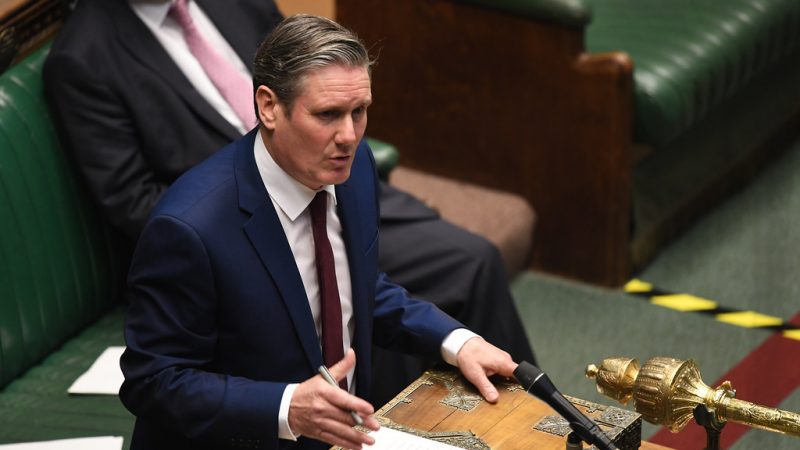The question is not whether Labour will win but how large their majority will be

If you only judged UK politics by how the leaders behaved, you’d think Labour was in a difficult position. Rishi Sunak seems content to sit on his hands and change virtually nothing ahead of the next election, while Keir Starmer is keeping tight control over all spending commitments and constantly changing his policies. All of this seems very odd when Labour is, in fact, comfortably leading in polls. Their behaviour makes a little more sense when you consider governments tend to recover near the election – but the data suggests that Sunak cannot rely on this trend anymore.
Keir Starmer’s energetic activity – dropping policies virtually every week, sacking senior Shadow Cabinet members and imposing tight limits on what Labour can promise – seems unnecessary if you look at the polls. In August, Labour led the Conservatives by 18 percentage points (45% to 27%), a 15pt swing in Labour’s favour compared to the 2019 general election.
After taking tactical voting into account, my projection model suggests this 18pt lead would deliver an overwhelming landslide majority for Starmer’s party, with the Conservatives reduced to 97 seats – the worst result in the history of the party. Many leading Conservative MPs would lose their seats, including Deputy PM Oliver Dowden, Chancellor Jeremy Hunt, Defence Secretary Grant Shapps and Commons Leader Penny Mordaunt.
Yet history suggests that this lead will not last. The next election is expected in October 2024, in just over a year. If we look at the past 20 elections (i.e. since 1945), we find that in the year leading up to an election, governments almost always recover support. There are only a handful of exceptions.
These figures will give some hope to the Conservatives, and concern Labour. There are multiple examples of governments narrowing the polling gap significantly in the year before an election – from the 20pt swing managed by Wilson in the year leading up to 1970, to the 9pt swing achieved by Johnson ahead of 2019. Labour might be worried. But I don’t think they should be.
In order to win a majority at the next general election (the only way to keep Sunak in Downing Street), the Conservatives must win the popular vote by approximately 7pts – the same as Cameron in 2015. At present, they trail Labour by 18pts, meaning in order to retain power the Conservatives must narrow the polling gap by a whopping 25 percentage points in just over a year. History does not give much comfort to Sunak in this regard. On average since 1945, governments have narrowed the polls by only 6pts in the final year of their term – if this trend is repeated in 2024, then Labour would win 43% of the vote to the Tories’ 30%, enough for a 118-seat parliamentary majority.
This is a far cry from the 25pt swing required to keep Sunak in Downing Street. Indeed, that sort of swing would be unprecedented. As Mark Pack’s PollBase archive shows, no party leader since polling records began has ever accomplished something like this. Harold Wilson came closest in 1969-1970, narrowing the polls by 20pts in just over a year, but he still lost. To defy historical trends, the Tories would need an exceptionally popular and charismatic leader – and leadership polling shows that right now, they don’t have one.
In August, Rishi Sunak’s net approval rating stagnated at -20pts, a far cry from the +3 he enjoyed upon becoming Prime Minister and substantially worse than Keir Starmer’s ratings (+1). Whilst technically an improvement compared to Truss and Johnson, it’s hardly something to boast about, and fairly miserable for a man who once enjoyed net ratings of +43 as Chancellor back in 2020.
On top of all of this, Labour’s prospects for the next election have been strengthened by the decline of the Scottish National Party (SNP). Since the resignation of Nicola Sturgeon, the SNP have been trending downwards in support, and are now projected to win only 27 seats – a loss of 21. Most of these would be gained by Labour, who are now estimated to win 21 seats (+20), their best result since 2010. This is significant, as it means Labour can more easily win a majority at the UK level.
In short, Keir Starmer is the overwhelming favourite to become PM at the next election. Historical trends point to only a modest recovery for Rishi Sunak’s Conservatives, still leaving them on course for a shattering defeat (albeit one that still leaves them in second place). The question is no longer whether Labour will win, but rather how large their majority will be – and given the 2019 landslide defeat, that is certainly not a sentence I expected to be writing so soon.
Ell Folan is the founder of Stats for Lefties
Image credit: Jessica Taylor / UK Parliament – Creative Commons
Left Foot Forward doesn't have the backing of big business or billionaires. We rely on the kind and generous support of ordinary people like you.
You can support hard-hitting journalism that holds the right to account, provides a forum for debate among progressives, and covers the stories the rest of the media ignore. Donate today.



